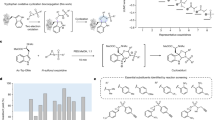Abstract
The origin of the differences in oxygen binding energy in various haemoglobins and myoglobins has long been debated. Perutz1 proposed that the haem-coordinated histidine (proximal histidine) strains the haem iron in low affinity globins but relaxes it in high affinity globins. The existence of such tension in T-structure deoxyhaemoglobin (deoxyHb) was recently confirmed by electron paramagnetic resonance (EPR)2,3, resonance Raman4,5 and NMR6 spectroscopy. Although its contribution to the free energy of cooperativity is insignificant in the deoxy state, the tension at the haem is considered to be ∼1 kcal mol−1 for the ligated form in which the haem iron moves into the porphyrin plane7. The remaining free energy is probably stored in other parts of the molecule. Therefore, a study of the stabilization mechanisms of the oxygenated form became increasingly important. A hydrogen bond between the bound oxygen and the distal histidine has been proposed by Pauling8; this would be expected to stabilize the oxy form of the protein and could contribute to the regulation of the oxygen affinity through the oxygen dissociation rate. A series of EPR and functional studies on various cobalt-substituted monomeric haemoglobins and myoglobins suggested the presence of such hydrogen bonding8–12 and it has recently been established in crystals of oxy iron myoglobin (oxyFeMb)13 and in oxyhaemoglobin14. Here we present resonance Raman spectra of the oxy forms of cobalt–porphyrin-substituted myoglobin and haemoglobin (CoMb and CoHb) recorded in buffered H2O and D2O solutions at 406.7 nm excitation. Only the Raman lines corresponding to the O—O stretching mode of the bound oxygen15, appearing near 1,130 cm−1, are shifted (2–5 cm−1) on replacement of H2O by D2O; no other vibrations, including the Co—O2 stretching mode, exhibit any frequency shifts. This indicates that the bound oxygen in oxyCoMb and in both subunits of oxyCoHb interacts with the adjacent exchangeable proton, and confirms the formation of a hydrogen bond between the bound oxygen and the distal histidine9.
This is a preview of subscription content, access via your institution
Access options
Subscribe to this journal
Receive 51 print issues and online access
$199.00 per year
only $3.90 per issue
Buy this article
- Purchase on Springer Link
- Instant access to full article PDF
Prices may be subject to local taxes which are calculated during checkout
Similar content being viewed by others
References
Perutz, M. F. Nature 228, 726–734 (1970).
Ikeda-Saito, M., Yamamoto, H. & Yonetani, T. J. biol. Chem. 252, 8639–8644 (1977).
Inubushi, T., Ikeda-Saito, M. & Yonetani, T. in Hemoglobin and Oxygen Binding (ed. Ho, C.) 199–204 (Elsevier, New York, 1982).
Nagai, K. & Kitagawa, T. Proc. natn. Acad, Sci. U.S.A. 77, 2033–2037 (1980).
Ondrias, M. R., Rousseau, D. L. & Simon, S. R. Science 213, 657–659 (1981).
Nagai, K. & LaMar, G. N. Biochemistry (in the press).
Perutz, M. F. et al. Biochemistry 17, 3640–3661 (1978).
Pauling, L. Nature 203, 182–183 (1964).
Yonetani, T., Yamamoto, H. & Iizuka, T. J. biol. Chem. 249, 2168–2174 (1974).
Ikeda-Saito, M., Iizuka, T., Yamamoto, H., Kayne, T. J. & Yonetani, T. J. biol. Chem. 252, 4882–4887 (1977).
Ikeda-Saito, M., Brunori, M. & Yonetani, T. Biochim. biophys. Acta 533, 173–180 (1978).
Ikeda-Saito, M., Hori, H., Inbushi, T. & Yonetani, T. J. biol. Chem. 256, 10267–10271 (1981).
Phillips, S. V. E. & Schoenborn, B. P. Nature 292, 81–82 (1981).
Schaanan, B. Nature 296, 683–684 (1982).
Tsubaki, M. & Yu, N. T. Proc. natn. Acad. Sci. U.S.A. 78, 3581–3585 (1981).
Barlow, C. H., Maxwell, J. C., Wallace, W. J. & Caughey, W. S. Biochem. biophys. Res. Commun. 55, 91–95 (1973).
Yonetani, T., Yamamoto, H. & Woodrow, G. V. J. biol. Chem. 249, 682–690 (1974).
Rousseau, D. L. J. Raman Spectrosc. 10, 94–99 (1981).
Tomita, S. & Riggs, A. J. biol. Chem. 245, 3104–3109 (1970).
Petsko, G. A., Rose, D., Tsernoglou, D., Ikeda-Saito, M. & Yonetani, T. in Frontiers of Biological Energetics (eds Dutton, P. L., Leigh, J. S. & Scarpa, A.) 1011–1016 (Academic, New York, 1978).
Author information
Authors and Affiliations
Rights and permissions
About this article
Cite this article
Kitagawa, T., Ondrias, M., Rousseau, D. et al. Evidence for hydrogen bonding of bound dioxygen to the distal histidine of oxycobalt myoglobin and haemoglobin. Nature 298, 869–871 (1982). https://doi.org/10.1038/298869a0
Received:
Accepted:
Issue Date:
DOI: https://doi.org/10.1038/298869a0
Comments
By submitting a comment you agree to abide by our Terms and Community Guidelines. If you find something abusive or that does not comply with our terms or guidelines please flag it as inappropriate.



